The Top 10 Amazing Things At Globe.
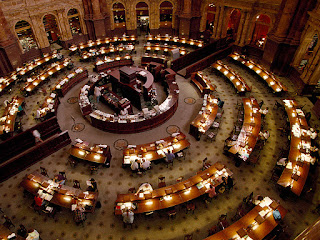 The Library of Congress in Washington DC is essentially both the national library of the U.S. and the country’s oldest federal cultural institution. Though it consists of only three buildings, it is the largest library in the world for shelf space and number of volumes. While open to the public for on-site research and as a tourist attraction, as the research institution of Congress, only members of Congress, Supreme Court justices, and other specified government officials can check out books. The library is formally known as the “library of last resort” in the U.S., charged with making certain items available to other national libraries if all other means have been exhausted. The library’s holdings are vast, including more than 32 million books, more than 61 million manuscripts, a rough draft of the Declaration of Independence, one of only four perfect vellum copies of the Gutenberg Bible in the world, over one million newspapers from the last three centuries, over five million maps, six million pieces of sheet music, and more than 14 millions photos and prints.
The Library of Congress in Washington DC is essentially both the national library of the U.S. and the country’s oldest federal cultural institution. Though it consists of only three buildings, it is the largest library in the world for shelf space and number of volumes. While open to the public for on-site research and as a tourist attraction, as the research institution of Congress, only members of Congress, Supreme Court justices, and other specified government officials can check out books. The library is formally known as the “library of last resort” in the U.S., charged with making certain items available to other national libraries if all other means have been exhausted. The library’s holdings are vast, including more than 32 million books, more than 61 million manuscripts, a rough draft of the Declaration of Independence, one of only four perfect vellum copies of the Gutenberg Bible in the world, over one million newspapers from the last three centuries, over five million maps, six million pieces of sheet music, and more than 14 millions photos and prints.
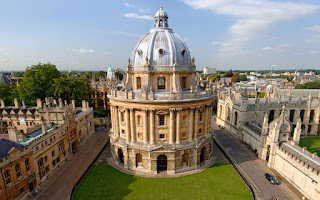 Established in 1602 as Oxford University’s library, Bodleian is one of the oldest libraries in Europe. The library houses more than 11 million items, including many of historical importance: four copies of the Magna Carta, a Gutenberg Bible, and Shakespeare’s First Folio (from 1623), just to name a few. Though Bodleian comprises multiple buildings, perhaps the most visually interesting is Radcliffe Camera, built in 1737-1749 to house the Radcliffe Science Library. The earliest circular library in England, Radcliffe has outlasted its 15 minutes of fame by appearing in multiple films, including Young Sherlock Holmes, The Saint, The Red Violin, and The Golden Compass.
Established in 1602 as Oxford University’s library, Bodleian is one of the oldest libraries in Europe. The library houses more than 11 million items, including many of historical importance: four copies of the Magna Carta, a Gutenberg Bible, and Shakespeare’s First Folio (from 1623), just to name a few. Though Bodleian comprises multiple buildings, perhaps the most visually interesting is Radcliffe Camera, built in 1737-1749 to house the Radcliffe Science Library. The earliest circular library in England, Radcliffe has outlasted its 15 minutes of fame by appearing in multiple films, including Young Sherlock Holmes, The Saint, The Red Violin, and The Golden Compass.
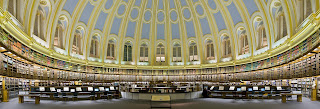 The Reading Room at the British Museum is located in the center of the Museum’s Great Court. The building’s domed exterior protects a unique interior ceiling made of a special kind of papier-mache, which is another first on our list! For much of the Room’s history, access was limited to registered researchers, attracting notable visitors including Karl Marx, Oscar Wilde, Mahatma Gandhi, Rudyard Kipling, George Orwell, Mark Twain, Lenin, and H.G. Wells during this time. The majority of the collection was moved to the new British Library in 2000; the Reading Room now houses an information center and a curated collection of specialty art and history titles relevant to the collections of the British Museum. The Reading Room has also been known to host long-running temporary exhibitions of its own, such as the 2006 exhibit centered on China’s famous Terracotta Army.
The Reading Room at the British Museum is located in the center of the Museum’s Great Court. The building’s domed exterior protects a unique interior ceiling made of a special kind of papier-mache, which is another first on our list! For much of the Room’s history, access was limited to registered researchers, attracting notable visitors including Karl Marx, Oscar Wilde, Mahatma Gandhi, Rudyard Kipling, George Orwell, Mark Twain, Lenin, and H.G. Wells during this time. The majority of the collection was moved to the new British Library in 2000; the Reading Room now houses an information center and a curated collection of specialty art and history titles relevant to the collections of the British Museum. The Reading Room has also been known to host long-running temporary exhibitions of its own, such as the 2006 exhibit centered on China’s famous Terracotta Army.
 The Yale University Beinecke Rare Book and Manuscript Library holds the distinction of being the largest building in the world that serves the express purpose of preserving rare books and manuscripts, which alone undoubtedly makes it one of the best libraries in the world. The library’s impressive holdings celebrate significant authors like Rudyard Kipling, D.H. Lawrence, Sinclair Lewis, and Joseph Conrad through its special collections. Beinecke’s central shelving area includes glass walls and soft lighting to protect the works from direct light. Accessible to the public as a tourist attraction, the library’s exhibition hall displays many of the library’s rare works, including one of only 48 copies in existence of a treasured Gutenberg Bible.
The Yale University Beinecke Rare Book and Manuscript Library holds the distinction of being the largest building in the world that serves the express purpose of preserving rare books and manuscripts, which alone undoubtedly makes it one of the best libraries in the world. The library’s impressive holdings celebrate significant authors like Rudyard Kipling, D.H. Lawrence, Sinclair Lewis, and Joseph Conrad through its special collections. Beinecke’s central shelving area includes glass walls and soft lighting to protect the works from direct light. Accessible to the public as a tourist attraction, the library’s exhibition hall displays many of the library’s rare works, including one of only 48 copies in existence of a treasured Gutenberg Bible.
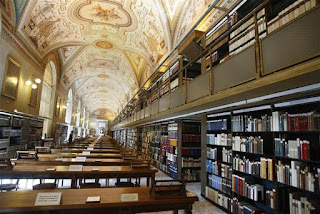 The Vatican Library, under the ecclesiastical jurisdiction of the Catholic Church in Rome, is one of the oldest libraries in the world. Though it was formally established in 1475, its existence in early forms dates back to the origins of the Catholic Church. For nearly 600 years, the library has added to its collection through historic acquisitions, generous bequests, and gracious gifts. The Vatican Library currently holds mor than 1.1 million books, 75,000 manuscripts, and over 8,500 incunabula. Fittingly, the library owns the oldest complete manuscript of the Bible, as well as many other significant works from medieval times.
The Vatican Library, under the ecclesiastical jurisdiction of the Catholic Church in Rome, is one of the oldest libraries in the world. Though it was formally established in 1475, its existence in early forms dates back to the origins of the Catholic Church. For nearly 600 years, the library has added to its collection through historic acquisitions, generous bequests, and gracious gifts. The Vatican Library currently holds mor than 1.1 million books, 75,000 manuscripts, and over 8,500 incunabula. Fittingly, the library owns the oldest complete manuscript of the Bible, as well as many other significant works from medieval times.
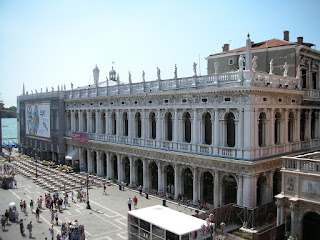 Fittingly housed in a Renaissance building in Venice, the National Library of St. Mark’s contains one of the most important collections of classical texts in the world. Though its lengthy construction period would not begin until 1537, collecting for the library began as early as 1468 with a gift from Cardinal Bessarion of 250 manuscripts and 750 codices. As of 1603, a law was enacted that required one copy of all books printed in Venice to be housed at the National Library. Today, the collection encompasses more than a million books, over 13,000 manuscripts, 2,883 incunabula, and more than 24,000 16th-century works.
Fittingly housed in a Renaissance building in Venice, the National Library of St. Mark’s contains one of the most important collections of classical texts in the world. Though its lengthy construction period would not begin until 1537, collecting for the library began as early as 1468 with a gift from Cardinal Bessarion of 250 manuscripts and 750 codices. As of 1603, a law was enacted that required one copy of all books printed in Venice to be housed at the National Library. Today, the collection encompasses more than a million books, over 13,000 manuscripts, 2,883 incunabula, and more than 24,000 16th-century works.
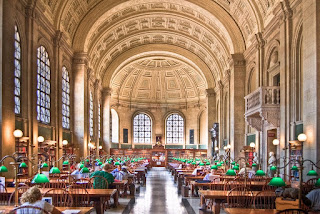 Established in 1848, Boston Public Library was the first publicly supported library in the United States and, with its present collection of 22 million items, also the second-largest. The Central Library consists of two buildings, the Johnson Building and the McKim Building, which houses the library’s research collection and exhibitions. Built in 1895, McKim contains many beautiful murals, including Edward Abbey’s famous scene depicting the legend of the Holy Grail. The main room of the McKim building — Bates Hall — also features a unique coffered ceiling. More than 1.7 million rarities are included in the research collection at McKim, including medieval manuscripts, incunabula, early Shakespeare that includes a First Folio, colonial Boston records, and a major Daniel Defoe collection. The collection is also home to the libraries of several notable figures in American history, including John Adams, William Lloyd Garrison, and Nathaniel Bowditch.
Established in 1848, Boston Public Library was the first publicly supported library in the United States and, with its present collection of 22 million items, also the second-largest. The Central Library consists of two buildings, the Johnson Building and the McKim Building, which houses the library’s research collection and exhibitions. Built in 1895, McKim contains many beautiful murals, including Edward Abbey’s famous scene depicting the legend of the Holy Grail. The main room of the McKim building — Bates Hall — also features a unique coffered ceiling. More than 1.7 million rarities are included in the research collection at McKim, including medieval manuscripts, incunabula, early Shakespeare that includes a First Folio, colonial Boston records, and a major Daniel Defoe collection. The collection is also home to the libraries of several notable figures in American history, including John Adams, William Lloyd Garrison, and Nathaniel Bowditch.
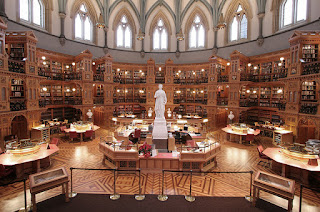 The Library of Parliament in Ottawa, Canada holds a special distinction on our list, as it is the only library of such prominence that its likeness is printed on the country’s currency (it is featured on Canada’s ten dollar bill). The design of this national landmark was inspired by the British Museum Reading Room, and includes walls supported by 16 flying buttresses, a vaulted ceiling in the main reading room, and white pine paneling with beautifully detailed carvings of flowers, masks, and mythical creatures. The collection encompasses more than 600,000 items, which is curated by a dedicated 300-member staff. While access to the facility is generally restricted to Canadian parliamentary business, tours are often made available to the public.
The Library of Parliament in Ottawa, Canada holds a special distinction on our list, as it is the only library of such prominence that its likeness is printed on the country’s currency (it is featured on Canada’s ten dollar bill). The design of this national landmark was inspired by the British Museum Reading Room, and includes walls supported by 16 flying buttresses, a vaulted ceiling in the main reading room, and white pine paneling with beautifully detailed carvings of flowers, masks, and mythical creatures. The collection encompasses more than 600,000 items, which is curated by a dedicated 300-member staff. While access to the facility is generally restricted to Canadian parliamentary business, tours are often made available to the public.
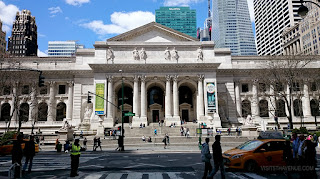 The New York Public Library is awe-inspiring for its scope and breadth. As the third largest library in North America with more than 50 million items in its collection, it encompasses 87 libraries serving 3.5 million people across the state. The Rose Main Reading Room acts as the centerpiece of the library, with grand arched windows along its 52-foot walls, and also featuring chandeliers and a gilded and painted ceiling. The library acquired America’s first Gutenberg Bible, and also houses collections with a special emphasis on Americana literature and printed materials. Among the most recognizable sites on our list, the library has made multiple appearances in feature films, as a key setting in the film The Day After Tomorrow and as a prominent backdrop in the original Ghostbusters, among others.
The New York Public Library is awe-inspiring for its scope and breadth. As the third largest library in North America with more than 50 million items in its collection, it encompasses 87 libraries serving 3.5 million people across the state. The Rose Main Reading Room acts as the centerpiece of the library, with grand arched windows along its 52-foot walls, and also featuring chandeliers and a gilded and painted ceiling. The library acquired America’s first Gutenberg Bible, and also houses collections with a special emphasis on Americana literature and printed materials. Among the most recognizable sites on our list, the library has made multiple appearances in feature films, as a key setting in the film The Day After Tomorrow and as a prominent backdrop in the original Ghostbusters, among others.
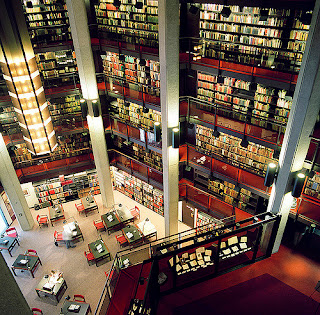 Affiliated with the University of Toronto, the Thomas Fisher Rare Book Library houses more rare books than any other collection in Canada. The collection includes unique artifacts like Newton’s Principia (1687), Shakespeare’s First Folio, the Nuremberg Chronicle (1493), and a Babylonian cuneiform tablet dating to 1789 BC. Robert S. Kenny, a Communist Party of Canada member, also donated a large part of the collection. In all, the rare book library includes more than 25,000 items with a special focus in labor movements worldwide, though with a particular emphasis on Canada and its history.
Affiliated with the University of Toronto, the Thomas Fisher Rare Book Library houses more rare books than any other collection in Canada. The collection includes unique artifacts like Newton’s Principia (1687), Shakespeare’s First Folio, the Nuremberg Chronicle (1493), and a Babylonian cuneiform tablet dating to 1789 BC. Robert S. Kenny, a Communist Party of Canada member, also donated a large part of the collection. In all, the rare book library includes more than 25,000 items with a special focus in labor movements worldwide, though with a particular emphasis on Canada and its history.
No comments:
Post a Comment